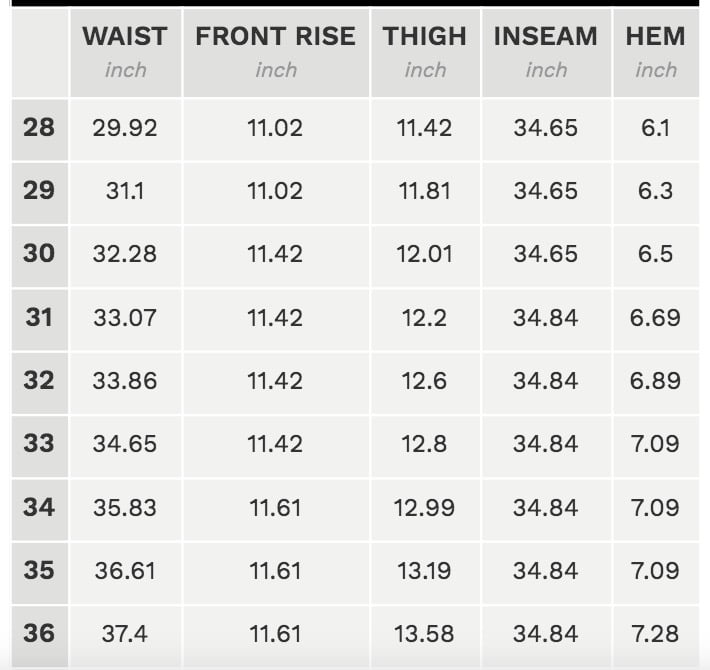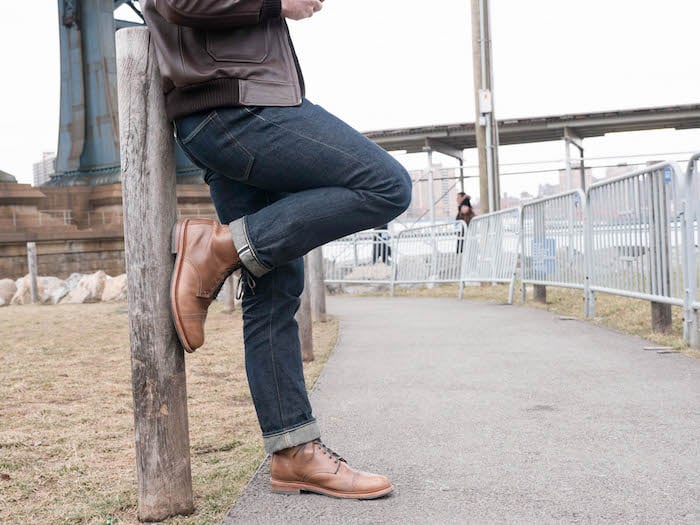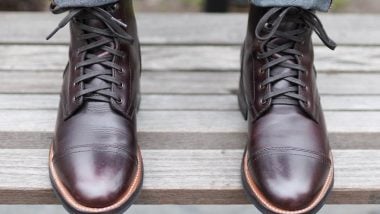Rookie Mistakes: 5 Raw Denim Mistakes to Avoid
We’ve all been there. Whether you’re diehard denim collector or just a fade fanboy, we all came into the world of raw denim as rookies, and rookies make mistakes. We’ve probably ruined at least a pair or two on the way, but this is how we learn. 
When I was a brand new denim hobbyist, I fell into five traps (the Big Five). I have determined these mistakes as “most common” through observing myself and others in the community. In addition to running my own platform for rugged wear, I am an active member of many community pages, denim social media outlets, and I’m a ravenous consumer of denim related content. These five issues crop up repeatedly. As such, it feels valid to call these common mistakes:
- Sizing
- Buying Into Hype
- Being a Brand Slave
- Denim Care
- Staying the Course
Kosher? Great, let’s press on and discuss these common mistakes and how to address them.
[Further reading: Is Selvedge Denim Worth It?]
1. Sizing
I shit the bed so many times when it came to sizing and buying my first pairs of selvedge denim. Simply put, I failed to understand the difference between vanity sizing and true measurements. How different could true and vanity sizing be? Shouldn’t true measures be universal among brands?
Lawd have mercy, sizing isn’t even consistent across the same manufacturer’s cuts. This is so important to be aware of; otherwise, you’re liable to end up with some ill-fitting jeans. Tag sizing might as well be arbitrary.
To make sure you get what you need for size, get a cloth measuring tape at your local CVS. Take waist, hip, thigh, knee, leg opening, and inseam measurements on your best-fitting pair of jeans. Then compare those to the sizing chart for every brand and every cut.
Keep in mind, sizing may fluctuate, especially in made to order situations. There are margins of error expected with those kinds of projects, especially with brands less versed in custom-made denim.

Sanforized vs Unsanforized
Next, consider whether the denim is sanforized or unsanforized. Sanforized denim has undergone a process to remove most shrinkage from the fabric. Unsanforized denim has not been treated. It comes to you in its raw and dry state — Levi’s now defunct slogan of “shrink to fit” was because the denim was raw — and you can expect anywhere from 3-10% of shrinkage when you introduce water into the equation. Folks buying unsanforized denim, like Nick did with his Studio d’Artisan jeans, are expected to soak them in a bathtub prior to wearing.
Some shops may categorize their offerings as raw unsanforized or one-wash/soaked unsanforized, meaning they washed the jeans before sending them to you. Each option will have its own measurements for each tag size; they will not correlate with one another.
[Related: Sanforized vs Unsanforized: How to Pick]

The Stretch
Finally, many guys don’t think about the fact that denim stretches once it’s been worn, and different brands/denims will stretch more than others. Even if your denim is sanforized and even if you’ve been able to try them on before buying them, you must remember that they’ll likely stretch a good inch or more. Or less! It depends on the brand. You’ve got to ask a lot of questions of the person selling you the denim.
I know; it’s a lot to consider, right? I bought, wore, and sold many jeans in the beginning before I got a handle on this. If you don’t know, don’t understand, or just want someone to tell you what you need, ask. Sounds simple, but many people don’t. If you are like me, there isn’t a selvedge dealer in your area, which means you’re buying online. Send a quick email or go to any number of community pages; they will help you. You just need the measurements you took earlier.
[Related: Great Selvedge Jeans That Aren’t Raw]

2. Buying Into Hype
This one really got me. I got burned by self-inflicted over-excitement for a single brand and un-intentional peer pressure, or a juvenile need to fit in. Over-excitement for a brand resulted in the form of tunnel vision and overbuying. As for the need to fit in, it led me down an expensive path. I felt I needed to buy “elite brands” the way others had within the community to be taken seriously.
This was bad on many levels, but none worse than falling into “brand hype.” I am not sure which is worse, but this comes two-fold. There’s over-buying one brand, and then there’s the irrational need to keep up with the Joneses.
Then there’s that peer pressure one might feel to keep up with the community. There are plenty of opinions about the best and worst denim. Suppose it isn’t the opinions of others that eat away at rational decision making. In that case, it could be the self-inflicted FOMO caused by the bombardment of “denim icons” on social media wearing “Brand X.”
Don’t do it to yourself or your wallet. Instead, tighten the metaphorical belt and save for a really killer pair of well-made jeans. Most of those social media icons have built their collection over time and honestly, through trial and error, like anybody else. Take time, get to know a brand, and ask about it, but don’t try and keep pace with the internet. It’s only showing you what it wants you to see.
Decide what you like from a pair of jeans.
[Further Reading: The Best Selvedge Denim: 8 Solid Brands for Quality, Value, & Weirdness]

3. Being a Brand Slave
As if the hype wasn’t bad enough, there’s “the trap”: over-buying one brand without really exploring the broader world of denim brands. I made the switch to selvedge denim to pare down my wardrobe and only keep a handful of really well-made items. Then the excitement of how cool this lifestyle is, and the consumerism-fueled endorphins flooded my brain.
Old habits die hard, and even though I was buying “slow fashion” items, snatching up every cool pair of jeans I saw defeated the purpose. I was treating selvedge denim as fast fashion, and suddenly I had 16 pairs of barely worn, expensive-ass denim in my closet. And it wasn’t just the jeans. Something in my brain broke. I was rapidly over-spending and consuming belts, boots, wallets, and other everyday carry items. I had fallen for “The Hype.”
I was treating selvedge denim as fast fashion, and suddenly I had 16 pairs of barely worn, expensive-ass denim in my closet.
When it comes to over-buying a brand, there’s probably no real harm in it. However, it does make your wardrobe a little vanilla. Even if the brand offers lots of options, fits, and full wardrobe offerings, you end up looking like a walking billboard without the benefit of a paycheck. It also limits the excitement that comes with trying new brands.
Additionally, The Trap may cause nearsightedness. Buy from a single manufacturer, and you may become blind to issues of quality, construction, and details. This pitfall is avoidable either through research (challenging but not insurmountable) or self-control (much more complicated than research).
[Related: 7 Reasons Japanese Denim Is Worth the Cost]

4. Denim Care
Holy shit, if there was a topic more heatedly debated than religion and politics, it might be denim care. I will start this section by saying I definitely don’t have all the answers. There isn’t a one-size-fits-all approach. I can say that there are definitely some ridiculous approaches to denim care.
I work for a significant med-tech company specializing in infection management. I am a clinically credentialed specialist on the topic. There is plenty of data to establish indigo’s antimicrobial nature (Antimicrobial Activity of Indigofera suffruticosa, Leite, e.t al. 2006, and more). However, to make the statement that your jeans are antimicrobial is… well… stupid.
While this means we can at least assume natural indigo dyed cotton used in the production of denim is defensive in nature to the formation of bacterial colonies, there’s a substantial difference between passive defense and active bactericidal activity. Your jeans aren’t actively killing anything, except maybe your shot at a date if they smell.
Toss Levi’s CEO Chip Bergh’s statement that he “never washes his jeans” into that part of your brain for exciting but useless information. Your jeans need to be washed. Maybe not like the rest of your laundry, but you should consider it for special occasions. The average person sheds roughly 40K skin cells a day. That debris is made predominantly of devitalized collagen (i.e., bacteria food).
While your jeans may have some antimicrobial properties, solid chance your underoos do not, and your skin definitely doesn’t. So your jeans become a Golden Buffett for every microbe crawling around on your skin and grundies. You’ve created a feeding and breeding ground for bacterial colonies. Grim.
There are relatively comprehensive care lists out there in the interwebs. Personally, I like the IndigoProof.com approach:
- Cold water
- Gentle cycle
- Inside out
- Using a detergent suitable for protecting dark
- Skip the spin cycle and hang dry
And make sure you wash your jeans without any other clothes (except perhaps, other jeans) unless you like the idea of your whole wardrobe getting streaks of blue through them.
Do not freeze your jeans. At the very best, it slows the growth of bacteria without killing them. To kill bacteria via freezing, you’d have to reach temperatures exceeding -113.8F (-81C), which definitely exceeds the capabilities of household freezers.
Finally, even if you’re completely sold on the antibacterial properties of natural indigo, most Japanese jeans still use synthetic indigo. Most of the guys who proudly boast that they have magical natural indigo… don’t.
[Learn more: Inside Vietnam’s Raw Denim Community]

5. Staying The Course
This one doesn’t need to be hammered on. However, it is so important. It’s the entire premise and argument for the Indigo Invitational competition. If you’ve fallen victim to The Trap or The Hype, hell, even both, you’ll end up with a closet full of loved but unworn denim.
That may be the cardinal sin of raw denim addicts. Sure, collecting is part of this game. Seeing something you love and adding it to the rotation is standard practice. However, those fades you’re obsessing over when you scroll your IG feed are the result of patience. A five- or six-pair rotation of beautifully faded pairs might be the result of a decade or more of patient fading. You can’t buy your way to this result. You have to wait for it.
The goal for most of us is raw denim evolution. Fading is about creating a narrative, displayed on our jeans, through meaningful wear and tear over time and adventure. If you can resist the urge to stuff the guts of your closet with countless pairs of jeans, you will get to experience the real joy of fading denim.
In short, patience is crucial and at the heart of all of these common mistakes.
In short, patience is crucial and at the heart of all of these common mistakes. Mastering patience will help you avoid falling victim to “The Hype” and “The Trap” by helping you consider what you really want and how to identify quality products. Patience will help truly understand sizing needs and help get the fades we all covet.
Patience will even help with your denim care through understanding the process. However, please wash your jeans when they need it because your loved ones will lose patience with your hobby if you don’t.










Great guide, thanks for sharing. Do you have comments on Uniqlo selvedge denim? They are way below the price tag of high quality Japanese jeans, but I wonder if they do the job, at least to get started into raw denim.
I don’t, but I keep getting asked that — maybe I’ll get a review done!
I would be interested in your thoughts as well on the Uniqlo selvedge brand. It seems good quality for the price.
Yeah it’s very curious how they make such cheap selvedge! I do need to look into it.
Great advice all around. Quite sobering and very useful. I am so glad I came across your article while I am only two pairs of selvedge into my “collection”. I will definitely follow your advice. No more purchases for me until I’ve shredded these bad boys. Actually, just cancelled my order for a pair of Kato’s. Feels liberating somehow. Thanks a ton!
Oh wow! Well don’t forget to have fun along the way, don’t let this article sober you too much Zee!
Hello,
thank you for the nice balanced article. I enjoyed reading about your experiences. As a rookie, I found this article helpful.
I realise this suggestion is perhaps a bit nit picky, but it would be helpful if the authors name and article publishing date were at the top of the article.
Thank you.
Thanks for the feedback Jim! Glad you liked the piece. I’m not great at web design stuff but I’ll look into that request